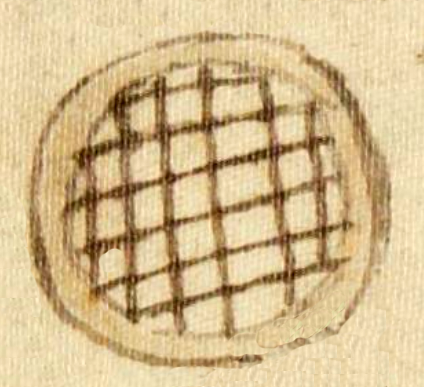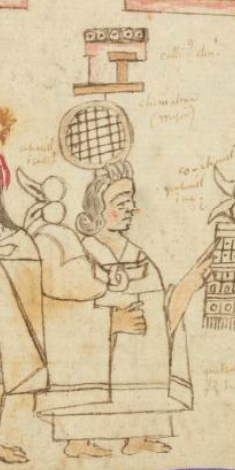Chimalman (Azca9)
This black-line drawing of the simplex glyph for the personal name Chimalman, (“She is Like a Shield," attested here as a woman’s name) shows a round shield with a mesh pattern and a plain border. Above the shield is a glyph for a tecpan (royal palace), which may or may not be part of her name. The second part of her name, which some see as "-ma" (from hand, bearer) or, as preferred here, "-man" (from -mani, in the manner of), is not shown visually.
Stephanie Wood
Other manuscripts offer varying designs for the shield associated with this name. The jury is still out, but if the name ends in -man, this would render a translation of "She is Like a Shield." If the second part of her name is -ma, then some see a reference to the hand (maitl), and thus some translate her name as "Shield Bearer." But Chimalmama ("She Carries a Shield") also comes close to that translation, and the stem for mama (to carry) could be man-. Sometimes names are apocopated, dropping letters at the end.
Chimalman was the name of a famous deity-bearer--carrying Huitzilopochtli and/or his accoutrements) in the famous migration from Aztlan captured in the Tira de la Peregrinación. (See: Angela Herren Rajagopalan, Portraying the Aztec Past, 2018, 29.) For Alfredo López Austin (The Myth of Quetzalcoatl, 2015, 150), Chimalman was a progenitor/mother worthy of note, related to the concept of mother earth. In this case, from the Matrícula de Huexotzinco, the name is being used by what may be a macehualli woman. She does not have a title by her name, such as the imported term, doña.
Stephanie Wood
chimalma
(mujer)
Chimalman (mujer)
Stephanie Wood
post-1550, possibly from the early seventeenth century
Jeff Haskett-Wood
escudos, rodelas, armas, guerra, nombres de mujeres, mujeres famosas, migraciones, Aztlan

Chimalman, famous migration leader, https://nahuatl.wired-humanities.org/content/Chimalman
chimal(li), war shield, https://nahuatl.wired-humanities.org/content/chimalli
-man(i), to be in the manner of, https://nahuatl.wired-humanities.org/content/mani-1
ma(itl), hand or arm, https://nahuatl.wired-humanities.org/content/maitl
Al Estilo de una Rodela, o Portadora de un Escudo
The Codex Azcatitlan is also known as the Histoire mexicaine, [Manuscrit] Mexicain 59–64. It is housed in the Bibliothèque Nationale de France, and hosted on line by the World Digital Library and the Library of Congress.
https://www.loc.gov/resource/gdcwdl.wdl_15280/?sp=9&st=image
The Library of Congress is “unaware of any copyright or other restrictions in the World Digital Library Collection.” But please cite Bibliothèque Nationale de France and this Visual Lexicon of Aztec Hieroglyphs.








